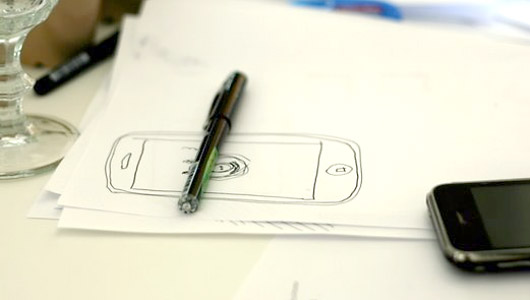The conceptual design services I offer is the fast track from ideas to solution. With the help of design workshops, paper sketches and concept specifications I turn visions into a tangible solution.
Conceptual design
When the initial phase of identifying target groups and stating the over all requirements is done the actual software is to be designed. This needs to be done both from a technical perspective and an interface perspective. According to my experience the best results is created when these aspect are focused on simultaneously. By letting technicians and designers work side by side in this design process a lot of time and effort can be saved. I recommend that the clients are closely involved throughout the process. This gives the clients the opportunity to contribute their expertise and make rapid decisions. In order for this to happen, the design process needs to be done in a way that everyone can follow, even if they lack experience with IT-products. This is why i worked out this method for conceptual development.
Paper sketches
A conceptual story board for a search function on a e-commerce site. When the user types a search word the systen dynamically offers suggestions for products that the user might be looking for.
I have outlined effective way of using hand drawn paper sketches as a tool for conceptual interface design. The basic idea is to use pen and paper to visualize each screen or logical view in a system while discussing it. It is obviously that it is much easier to understand what somebody says if he or she draws a picture while talking, especially in complex matters like technical solutions. Hand drawn sketches are considerably faster to work with than any design application in a computer and it is easy and risk free to put one aside if you like to try another idea. The sketches are not only used for communication and inspiration. They can also be used as the foundation for the technical specification. By adding more details and presenting the functionality as storyboards even the most complex layout and interaction can be conveyed.
Design workshops
I have found that the most effective way to develop the fundamental parts of an interactive solution and illustrate how they all are connected is by conducting design workshops. By gartering all major stake holders from the client as well as the development team a feasible solution outlined instantly. The discussion focuses on the user experience all concerns can be taken into account. My role in such a workshop is to moderate the discussion and add my experience in interface designand usability.
User scenarios and specification
In order to understand how the pages fit together I define usage scenarios. Such a scenario is a story about how a user interact with the system to complete a task or fill a goal step by step. Each step is ilustrated by sketches and storyboards. The scenario and each containing page is then specified in text, explaining in a straight forward language how the page should work. Using these tools you can describe even the most complex solution in a way anyone can understand. This method is much faster than traditional requirement handling. It prevents the development team from getting stuck in details and help them to keep track of the bigger picture.



